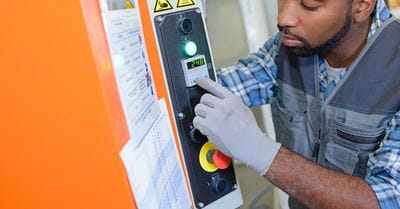Vertical Reciprocating Conveyors | Tucson

Raymond West supplies warehouse automation equipment such as VRC's.
We are among the largest suppliers of warehouse automation equipment in the state.
Call us today at (520) 729-4222.
What Is a Vertical Reciprocating Conveyor (VRC)?
A VRC is a safe, economical, convenient way to transport materials from one level to another. VRCs have use case scenarios in many different industries, including manufacturing plants, storage facilities, distribution centers, and other multi-level operations. These versatile pieces of equipment can be readily integrated with a building’s mezzanine, balcony, basement or any higher story levels.
Vertical reciprocating conveyors are made up of a shaft, a cage, and a hydraulic or mechanical system. Vertical material lifts can be installed almost anywhere inside or outside of a building. Barriers and enclosures surrounding a VRC shaft ensure employee safety and well being.
What Are Some Advantages of VRCs?
Safety: Many facilities rely on forklifts to move their materials and merchandise from one level to another. While ideal for moving many different materials, forklifts are mainly intended for the horizontal movement of materials. In the name of efficiency, workers may sometimes stretch their forklifts above their height limit or move loads beyond their truck’s capacity rating. When such infractions happen, the chances of an accident increase substantially.
For some vertical product movement, vertical reciprocating conveyors offer a safe and effective replacement for lift trucks. Specifically engineered and fabricated for each operation’s application requirements, VRCs greatly minimize the likelihood of human error.
In addition, vertical material lifts are engineered to lift more substantial loads more frequently. These faster cycle rates mean less labor expenses. For companies that have high volume vertical lifting demands, VRCs can enhance safety and decrease costs.
Customization: One significant benefit to vertical reciprocating conveyors is the degree to which they can be customized. Since passenger elevators are designed to safely move people, there are numerous regulations that limit the weight capacity, speed and size of these machines. While such safety measures are necessary and advisable for safely transporting humans, they are prohibitive for high volume movement of products in manufacturing plants, warehouses and distribution centers. Vertical lifts can be readily customized because they are not saddled with the same laws as passenger lifts.
Regulation: Vertical reciprocating conveyors are designed to move materials only, while standard elevators are meant to move both people and materials. Due to this important difference, VRCs are spared from the strict elevator regulations in many states.
In lieu of local code, VRCs are regulated by their own national code that is overseen by the American Society of Mechanical Engineers (ASME), one of the preeminent standards shaping associations in the nation. More specifically, vertical reciprocating conveyors must comply with ASME’s Safety Standard for Conveyor and Related Equipment (ASME B20.1-2018). This standard outlines the rules for the fabrication, installation, operating procedure and maintenance of conveyor systems.
Raymond West Is A Full Service Supplier of Vertical Reciprocating Conveyors
If you’re in the market for a VRC, have questions or need engineering assistance, Raymond West can help. Our conveyor system experts can help design, procure, set up and service a system that’s suitable for your operation. Get in touch with us today!
Raymond West's Tucson facility serves Pima County, including Tucson, South Tucson, Marana, Oro Valley, Sahuarita and surrounding areas
Raymond West | Tucson Material Handling Equipment Supplier
Tucson Service Area
(520) 729-4222

